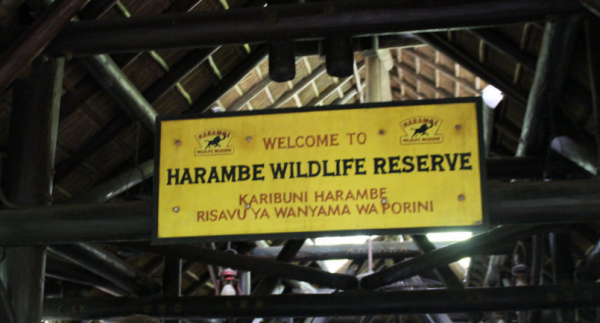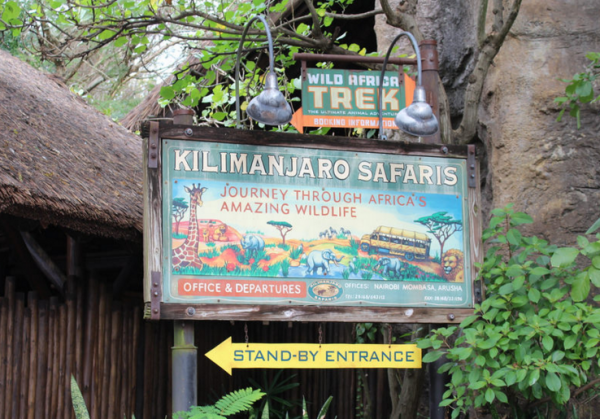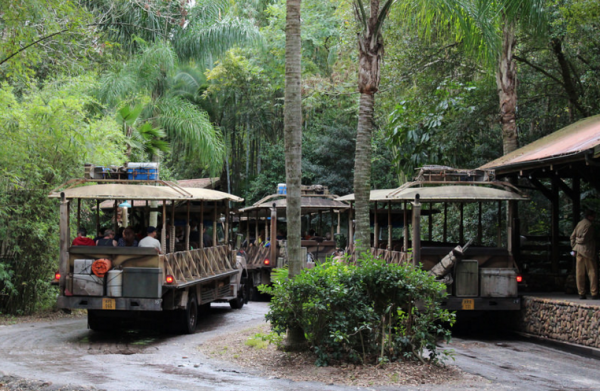
Kilimanjaro Safaris was one of the opening day attractions in Disney’s Animal Kingdom, and it continues to be one of the park’s most popular draws. This live safari operates only during daylight hours, so guests who are interested in booking passage on the “two week” safari should make a beeline for the ride first thing in the morning to get in line or grab a FastPass.
Though the basic premise of this attraction has remained the same since opening day, the storyline behind Kilimanjaro Safaris has changed dramatically. Prior to the park’s opening, this safari told the grisly tale of an elephant that had been poached. The ride included a model of the elephant’s bloody corpse visibly missing the prized tusks. Testers found the scene far too disturbing for a Disney attraction and it was removed before the park officially opened.
After the corpse was pulled, it was briefly stored backstage. One unconfirmed story some Cast Members have heard even tells of a local pilot who saw the fake corpse while flying over the park and tried to report Disney for inhumane treatment, believing the dead elephant laying backstage to be real.
The ride opened to guests with a story that included the disappearance of “Big Red” but didn’t show the elephant’s death. In fact, the only fake elephant guests saw was the baby elephant, “Little Red,” who was supposedly rescued by the guests on the safari. This version of the safari began as a laid back two-week trek through the savannah that took a detour when the guests heard about poachers trespassing in the park. A fast bumpy chase ensued, the guests stopped the poachers, and everyone went home with a compelling lesson about the dangers of poaching in Africa.
In 2007, the story was toned down. The guests were told of a baby elephant wandering the park and were asked to keep an eye out for it. Though they still found the elephant and briefly encountered the poachers, the message was far vaguer.
Finally, in 2012, Kilimanjaro Safaris lost the last lingering message about the harsh realities of poaching in Africa. Poachers and Baby Red have disappeared along with all radio chatter between the tour guide and the game warden that warned of poaching and set up any kind of story line. The bumpy chase is long gone, and even the unstable bridge that would rock from side to side remains stubbornly secure.
The latest incarnation of Kilimanjaro Safaris makes this little more than a scenic drive, but the ride hasn’t lost its appeal. Even without a story line, guests are able to see the free roaming animals that surround the safari trucks and this, after all, is what most people are really there for.
The most common questions that guests ask about the safari is whether the trucks are on a track and whether the animals are really free to approach the vehicle. The massive safari trucks that you board on this attraction are absolutely real. There’s no smoke and mirrors about these vehicles. Your safari driver really is driving the truck. The trucks are parked in a large backstage lot each night and driven at a maddeningly slow pace out to the attraction each and every morning.
Unlike most spieling attractions where the steering wheel is all for show, your driver on Kilimanjaro Safaris is really doing all the work. This is essential for many reasons, but foremost is the answer to question number two. The animals here are free roaming. Drivers will often need to swerve to one side of the road or another to scoot past a stubborn giraffe. While they can’t leave the road entirely, there’s enough wiggle room to help them navigate the savannah safely.
When animals stand directly in the ride path, however, drivers simply have to stop and wait them out. Obviously, these types of delays can cause a disappointing back up for guests stuck in trucks without an exciting view. While drivers can’t honk at the animals or otherwise encourage them to move, they can radio for assistance if a back up lasts for too long. A team of animal care specialists can come out when needed to gently persuade troublesome animals to move along.
While the animals are indeed free roaming in their own environments, the entire safari is not a free for all for every creature. Animals are separated for their own safety and predators are always kept away from prey. The means of separating and confining the animals is carefully concealed to preserve the illusion of an open landscape. Hidden moats and fences keep predators safely confined to their habitats. The chains that the trucks drive over between areas play a part in keeping the animals separated as well.
How do you make sure the animals are visible in this vast landscape? Sometimes you can’t. The lions are notoriously difficult to spot. Transplants from a cooler environment, the big cats had a difficult time transitioning to Florida. The spot where the lions now lay is the location of an air conditioning vent.
As if driving the freely moving safari truck wasn’t difficult enough, Cast Members at Kilimanjaro Safaris are also charged with the task of spotting various animals on each pass through and pointing them out to guests. While the basic spiel is the same, it needs to change constantly to accommodate the varying locations of each animal. Over time, Cast Members learn various tricks for spotting the different species, as well as how to time the tour so they can slow down for the best photo ops without backing up every truck behind them.
Working at Kilimanjaro Safaris is a challenging gig to be sure, but this is also a very unique opportunity among Disney attractions. The ride is a little different every time and you have a much better chance of seeing something rare when you make the trip over and over throughout the day. If you want to experience what Animal Kingdom is really all about, this is a family-friendly attraction that you shouldn’t miss.



Comments
Loved being a safari driver. Was an amazing experience. Hate that the storyline has changed as it was the point of the ride and I always did my best to make it fun and informative. I also loved trying to get the truck to a blistering 14mph in the poachers scene! Kwaharini!
I loved being a Kilimanjaro Safari driver too! It was the best experience of my life! I miss it and the animals. I love Pot Holes!
I love being a safari driver!! Nothing better than be out on the open savannah and seeing beautiful animals every day!! KSR is the best! Kwaherini!
My exwife used to drive this ride. When the drivers hit the rickety bridge they didn't know whether it would work or not so their reactions were genuine. There was also this particular rhino that would see her coming and deliberately sit in the road in front of her to get treats from the rangers. He trained them.
This is one of my favorite rides and when I did it in Oct. I was wonder why the stopped with Little Red. I only experienced it once where they called for help to get an animal going. But other wise it's fun when you stop due to an animal walking behind you or infront of you and it's a GREAT photo op. just depends where you are. I didn't know about the corps of the elephant. that's new to me